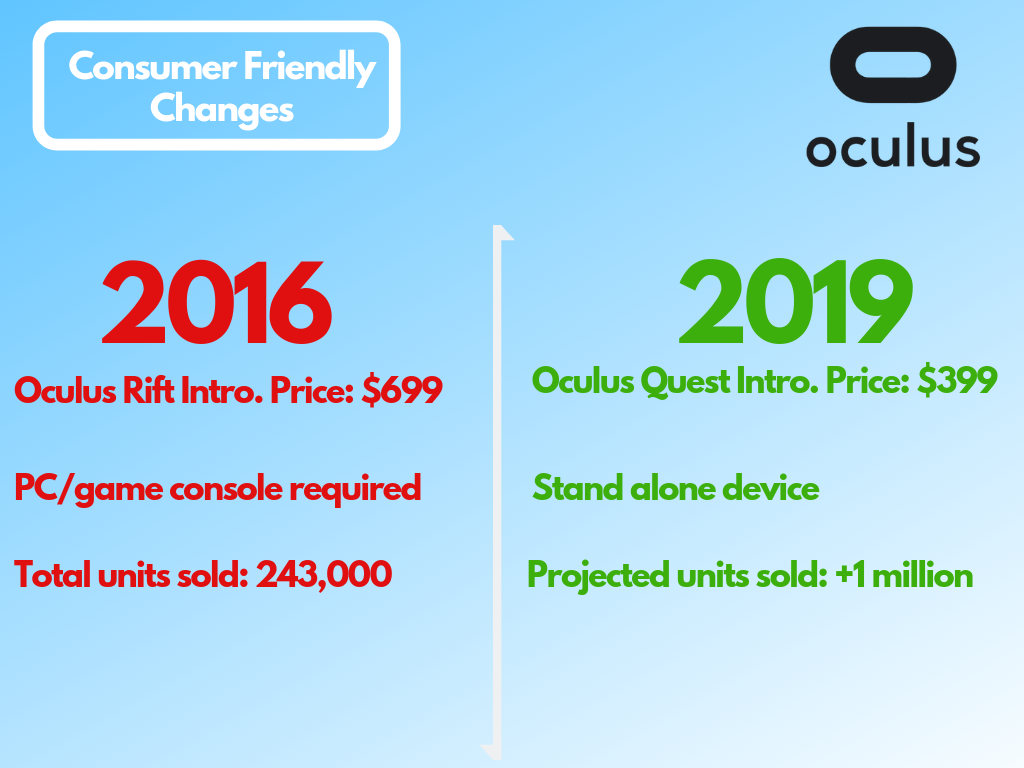Opportunity is at the door, and its name is Virtual Reality. VR has booming potential in transforming processes across many industries. Despite its huge promise, some perceived barriers-to-entry are hindering people from hopping on board with VR. Fortunately, these barriers can be broken once people are informed of what VR can do. Here are three perceived “barriers-to-entry” that are now broken.
Barrier #1: Pricing/Costs
Although VR has limitless potential and capabilities, costs and pricing prevents many from utilizing the technology’s power. A survey conducted by VR Intelligence in 2018 questioned 595 virtual reality professionals and found that 52% of the group believes pricing is a large barrier to entry. 65% of consumers believe pricing is the most powerful factor involved with purchasing a VR headset/device, and over half of all consumers would prefer to spend less than $400 on a headset. It is no secret that VR hardware has been expensive, but that is now changing.
How It’s Broken
Advancements in technology are alleviating costs and making VR more cost-friendly. The new release of the Oculus Quest, a stand-alone VR headset featuring six degrees of freedom (6DoF) meaning it can track your movements up, down, left, right, forward, and backward, allows for users to enjoy VR without a nearby PC, game consoles or external sensors. This means that less equipment is needed, saving thousands of dollars and increasing accessibility. Along with this, headset prices have been gradually falling over the years, making VR friendlier on your wallet. The aforementioned Oculus Quest is available for purchase at an average $399 price point.

As businesses realize these price cuts, they will reel in the advantages of VR technology. A Capgemini study found that 82% of companies that implemented VR indicated the extended reality systems met or exceeded their expectations. Furthermore, three-fourths of businesses that implemented VR found that the system gave them 10% increase in operational benefits. Continuing, VR, when used in training departments, has been shown to strongly increase learning retention, efficiency, safety, and training speed. Check out our previous article to learn more on how VR does all of these things. As the technology continues to improve, and more uses for VR are discovered, costs will continue to drop while ROI will grow.
Barrier #2: Intimidation/Culture Integration
It’s not uncommon for people to hesitate with new technology, whether it is based upon unfamiliarity, skepticism or intimidation. A 2016 study validated this, finding that 23% of consumers and businesses were hesitant to accept VR. This explains the hurdle for enterprise use of VR and whether it will be accepted into company culture. However, 3 years have passed, and the sentiment towards VR is changing.
How It’s Broken
People are becoming more familiar and comfortable with extended reality technology. A Nielsen study found that the public’s awareness of virtual reality devices increased from 28% in 2016, to 51% in 2017. The public is becoming more receptive towards VR as people become more informed and acute with the technology. One year ago, GE Healthcare implemented a new VR training program for their Healthcare Technology Management Professionals. The results were positive:
Amato DeRosa of Hartford Healthcare stated, “We have a few quantifiable outcomes achieved through the VR training technology. The obvious is cost savings by eliminating travel to a GE training facility. Less obvious, but equally important, is the boost to employee engagement and morale. We no longer must ask engineers to travel over the weekend and take time away from their families. We have seen a quality of life improvement, too.”
Employees were receptive and happy of the implementation, demonstrating that people are becoming fonder of the new technology.
Barrier #3: Limited Application
Some are unsure of how VR can be used in their business. After all, most think of gaming when they hear the words “virtual reality”. Many believe that entertainment is the only use case for VR, but this is far from the truth.
How It’s Broken
Content possibilities are endless: Training, education, data analysis, entertainment, communication, architecture, and even assisting paraplegics to regain some bodily functions are all powerful examples of how VR can be used. The gaming industry was an early adopter, but when people are introduced to VR’s capabilities and diverse use cases, they will realize it has unlimited potential! New startup Floreo is creating VR to help autistic children share joint attention and improve their social skills.
Although VR isn’t quite mainstream yet, it definitely isn’t going away. The International Data Corporation forecasts the VR market to reach over $20 billion in revenue this year, a nearly 69% increase from 2018. This signifies that people are realizing just how valuable VR can be for their businesses and personal life. Perceived barriers to entry are now broken, and people are beginning to explore the opportunity VR can bring them.
If you have questions about implementation, software development teams like ours with VR building capabilities can be great resources!
For more insight into the virtual world and its possibilities for you, reach out to our team at CodeTank Labs here.
Written By: Ethan Rosas & Lauren McNamara @ CodeTank Labs
Sources:
Dempsey, Tricia. “38+ Powerful Virtual Reality Statistics to Know in 2019.” G2, learn.g2.com/virtual-reality-statistics.
“Global VR Headset Shipments 2016 | Statistic.” Statista, www.statista.com/statistics/705476/global-virtual-reality-device-shipments-by-vendor/.
“GE Healthcare Introduces Virtual Reality Training for Healthcare Technology Management Professionals.” GE Newsroom, 1 June 2018, www.genewsroom.com/press-releases/ge-healthcare-introduces-virtual-reality-training-healthcare-technology-management.
“Worldwide Spending on Augmented and Virtual Reality Expected to Surpass $20 Billion in 2019, According to IDC.” IDC, www.idc.com/getdoc.jsp?containerId=prUS44511118.
“Augmented and Virtual Reality in Operations.” Capgemini, 2018, www.capgemini.com/wp-content/uploads/2018/09/AR-VR-in-Operations.pdf.
“SuperData Report Predicts Oculus Quest Sales Will Pass 1 Million Sales Next Year.” VRFocus, www.vrfocus.com/2018/10/superdata-report-predicts-oculus-quest-sales-will-pass-1-million-sales-next-year/.
Parrish, Kevin. “VR Pros Still Believe Pricing, Content Is Holding Back Mass Adoption.” Digital Trends, Digital Trends, 13 Aug. 2018, www.digitaltrends.com/computing/vr-pros-see-pricing-and-content-as-mainstream-barriers/.
Durbin, Joe. “VR/AR’s Biggest Obstacle: Lack of Content.” VentureBeat, VentureBeat, 17 Sept. 2016, venturebeat.com/2016/09/18/vrars-biggest-obstacle-lack-of-content/.
“VR Intelligence.” XR Industry Survey Report | VR Intelligence, www.vr-intelligence.com/xr-industry-survey-report.
